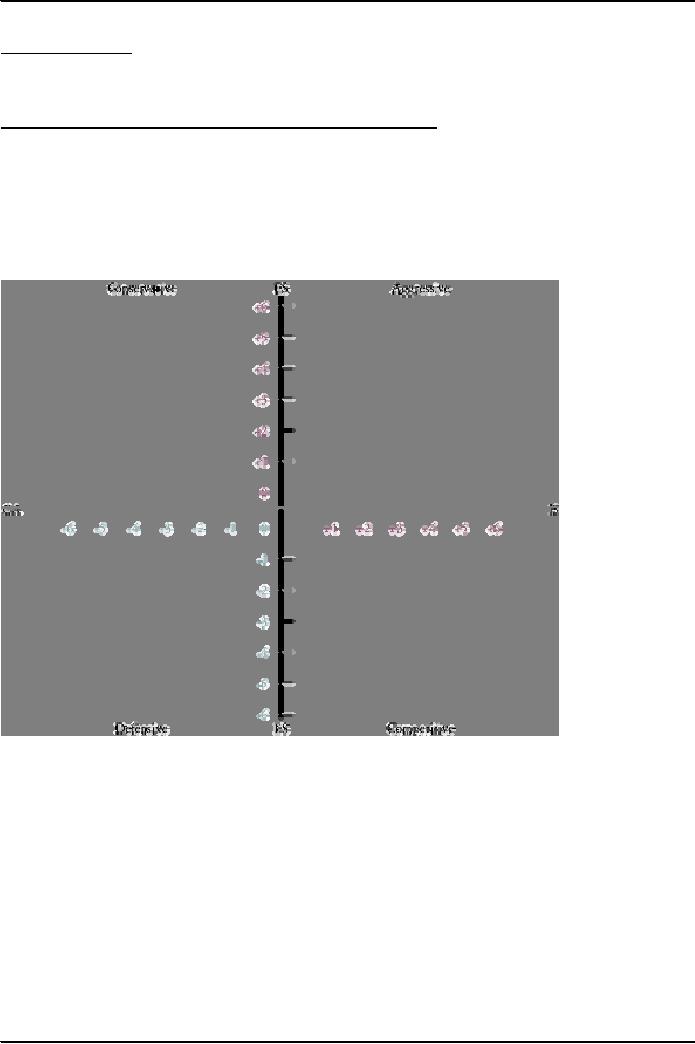 |
THE STRATEGIC POSITION AND ACTION EVALUATION (SPACE) MATRIX |
| << THREATS-OPPORTUNITIES-WEAKNESSES-STRENGTHS (TOWS) MATRIX:WT Strategies |
| THE STRATEGIC POSITION AND ACTION EVALUATION (SPACE) MATRIX >> |

Strategic
Management MGT603
VU
Lesson
25
THE
STRATEGIC POSITION AND ACTION EVALUATION
(SPACE) MATRIX
Learning
objective
After
understanding this chapter you are
able to understand SPACE
matrix and also understand
how to
prepare
the space matrix of any organization
and how it is helpful for
strategic formulation framework
The
Strategic Position and Action Evaluation
(SPACE) Matrix
The
Strategic Position and
Action Evaluation (SPACE) Matrix is
another important Stage 2 matching
tool
of
formulation framework. It explains that
what is our strategic position
and what possible action can
be
taken.
It is not closed matrix. It is
prepared on graph. It is closed
matrix. This follow counter clock
wise
direction.
It contains four-quadrant named
aggressive, conservative, defensive, or
competitive strategies.
The
axes of the SPACE Matrix
represent two internal
dimensions financial strength [FS]
and competitive
advantage
[CA]) and two external
dimensions (environmental stability [ES]
and industry strength
[IS]).
These
four factors are the most
important determinants of an
organization's overall strategic
position.
It
is divided into two internal
and external dimensions which are as
follow (Internal dimensions)
financial
strength,
competitive advantage, (External
dimensions) environment stability
and industry strength.
This
sequence
is convention to be followed as graphed
above. This frame work
determines appropriate set of
strategies
for each quadrant. First
quadrant is aggressive the firm fall in
this quadrant that fellow the
aggressive
strategy. Second quadrant is conservative
all those firms that fall n this quadrant
that must fallow
conservative
strategy and in next the
firm fellow the defensive
strategy. All the firms fall on
competitive
follow
that strategy. After a
rating is assigned ranging from +1
(worst) to +6 (best) to each of the
variables
that
make up the financial strength
and industry strength dimensions.
Assign a numerical value
ranging
from
-1 (best) to -6 (worst) to each of the
variables that make up the
environment stability and
Competitive
advantage
dimensions.
100
Table of Contents:
- NATURE OF STRATEGIC MANAGEMENT:Interpretation, Strategy evaluation
- KEY TERMS IN STRATEGIC MANAGEMENT:Adapting to change, Mission Statements
- INTERNAL FACTORS & LONG TERM GOALS:Strategies, Annual Objectives
- BENEFITS OF STRATEGIC MANAGEMENT:Non- financial Benefits, Nature of global competition
- COMPREHENSIVE STRATEGIC MODEL:Mission statement, Narrow Mission:
- CHARACTERISTICS OF A MISSION STATEMENT:A Declaration of Attitude
- EXTERNAL ASSESSMENT:The Nature of an External Audit, Economic Forces
- KEY EXTERNAL FACTORS:Economic Forces, Trends for the 2000’s USA
- EXTERNAL ASSESSMENT (KEY EXTERNAL FACTORS):Political, Governmental, and Legal Forces
- TECHNOLOGICAL FORCES:Technology-based issues
- INDUSTRY ANALYSIS:Global challenge, The Competitive Profile Matrix (CPM)
- IFE MATRIX:The Internal Factor Evaluation (IFE) Matrix, Internal Audit
- FUNCTIONS OF MANAGEMENT:Planning, Organizing, Motivating, Staffing
- FUNCTIONS OF MANAGEMENT:Customer Analysis, Product and Service Planning, Pricing
- INTERNAL ASSESSMENT (FINANCE/ACCOUNTING):Basic Types of Financial Ratios
- ANALYTICAL TOOLS:Research and Development, The functional support role
- THE INTERNAL FACTOR EVALUATION (IFE) MATRIX:Explanation
- TYPES OF STRATEGIES:The Nature of Long-Term Objectives, Integration Strategies
- TYPES OF STRATEGIES:Horizontal Integration, Michael Porter’s Generic Strategies
- TYPES OF STRATEGIES:Intensive Strategies, Market Development, Product Development
- TYPES OF STRATEGIES:Diversification Strategies, Conglomerate Diversification
- TYPES OF STRATEGIES:Guidelines for Divestiture, Guidelines for Liquidation
- STRATEGY-FORMULATION FRAMEWORK:A Comprehensive Strategy-Formulation Framework
- THREATS-OPPORTUNITIES-WEAKNESSES-STRENGTHS (TOWS) MATRIX:WT Strategies
- THE STRATEGIC POSITION AND ACTION EVALUATION (SPACE) MATRIX
- THE STRATEGIC POSITION AND ACTION EVALUATION (SPACE) MATRIX
- BOSTON CONSULTING GROUP (BCG) MATRIX:Cash cows, Question marks
- BOSTON CONSULTING GROUP (BCG) MATRIX:Steps for the development of IE matrix
- GRAND STRATEGY MATRIX:RAPID MARKET GROWTH, SLOW MARKET GROWTH
- GRAND STRATEGY MATRIX:Preparation of matrix, Key External Factors
- THE NATURE OF STRATEGY IMPLEMENTATION:Management Perspectives, The SMART criteria
- RESOURCE ALLOCATION
- ORGANIZATIONAL STRUCTURE:Divisional Structure, The Matrix Structure
- RESTRUCTURING:Characteristics, Results, Reengineering
- PRODUCTION/OPERATIONS CONCERNS WHEN IMPLEMENTING STRATEGIES:Philosophy
- MARKET SEGMENTATION:Demographic Segmentation, Behavioralistic Segmentation
- MARKET SEGMENTATION:Product Decisions, Distribution (Place) Decisions, Product Positioning
- FINANCE/ACCOUNTING ISSUES:DEBIT, USES OF PRO FORMA STATEMENTS
- RESEARCH AND DEVELOPMENT ISSUES
- STRATEGY REVIEW, EVALUATION AND CONTROL:Evaluation, The threat of new entrants
- PORTER SUPPLY CHAIN MODEL:The activities of the Value Chain, Support activities
- STRATEGY EVALUATION:Consistency, The process of evaluating Strategies
- REVIEWING BASES OF STRATEGY:Measuring Organizational Performance
- MEASURING ORGANIZATIONAL PERFORMANCE
- CHARACTERISTICS OF AN EFFECTIVE EVALUATION SYSTEM:Contingency Planning